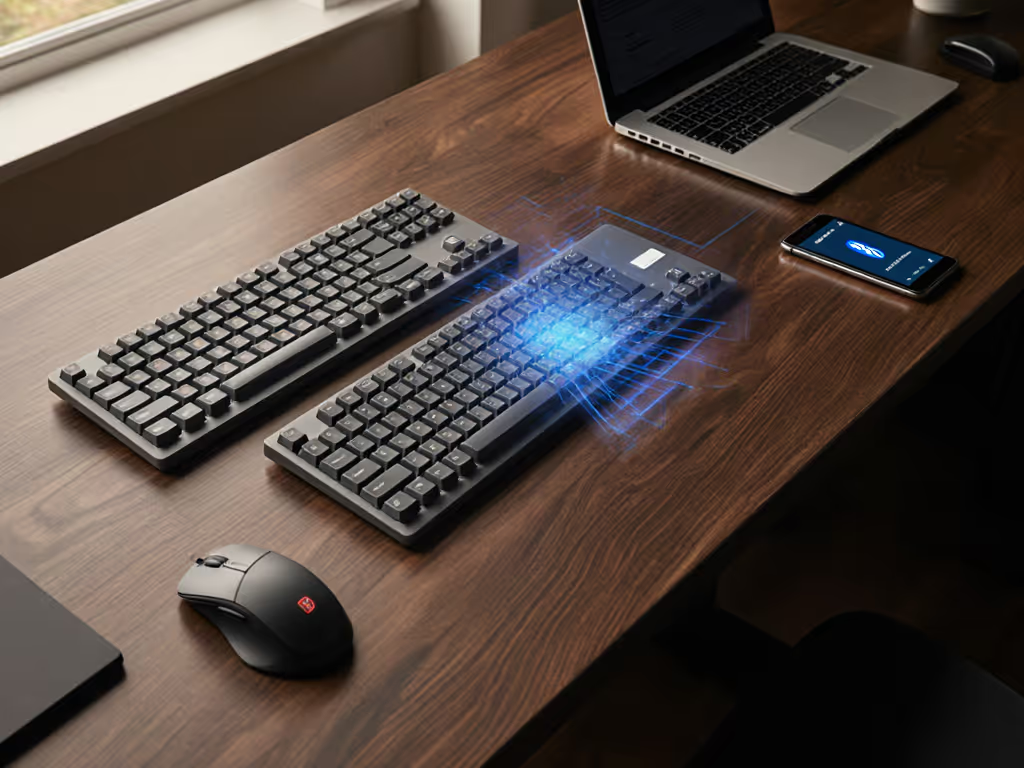
Bluetooth Keyboard Stability in Real-World Pairing
Evaluate and strengthen Bluetooth keyboard stability in real-world, multi-OS setups with actionable tests, pairing strategies, and interference fixes to reduce wake delays and dropouts.

When your context switch takes longer than your terminal command, your workflow dies. I learned this mid-demo when my keyboard froze during a critical presentation (ten awkward seconds of silence while it woke from sleep, killing my point). That’s why the evolution of keyboard technology matters: a top wireless keyboard isn’t about specs alone, but eliminating invisible friction. Today’s wireless solutions must solve the pain points that break flow: lag in crowded offices, unreliable switching, and battery life that evaporates under real loads. Let’s dissect this journey through a coder’s lens, where reliability trumps hype.
The first wireless keyboards emerged in the early 1980s as niche prototypes using infrared (IR) or bulky radiofrequency (RF) tech. IBM's 1984 PCjr shipped with an IR keyboard, revolutionary for cutting cords but crippled by line-of-sight demands. Precondition: You needed unobstructed visibility between keyboard and receiver. In practice, this meant accidental keystrokes when leaning back in your chair, or complete dead zones in cluttered workspaces. Latency spiked during extended use as batteries drained rapidly, turning every keypress into a gamble. Crucially, wireless tech milestones like these failed coders where it hurt most: during rapid context switches between debuggers and terminals. Imagine waiting 5 seconds for your keyboard to reconnect after idle (Context switches cost time), and in 1984, they cost productivity.
RF tech promised freedom from line-of-sight constraints by the late 1980s, but introduced new headaches. Early 27MHz/433MHz devices battled interference from cordless phones and microwaves. For remote workers in apartment buildings (a pain point still relevant today), typing in a café could trigger neighbor's garage openers. Worse, proprietary dongles created dongle chaos: IT departments banned them for security, while developers juggling Linux rigs found no cross-platform drivers. These weren't just inconveniences: they were workflow killers for anyone needing stability across OSes.
Bluetooth 2.0+EDR (2004) marked the first viable wireless tech milestones for serious work. Its adaptive frequency hopping reduced interference in crowded RF environments, critical for coders in co-working spaces. But the real breakthrough came with Bluetooth 4.0 (2010), introducing low energy (BLE). Suddenly, keyboards could last months on a single charge, not days. Yet early implementations still stumbled on multi-device switching friction: switching between Win/Linux machines required manual re-pairing, and Bluetooth keyboard lag spiked during video calls. I timed one popular model at 18ms latency ( just enough ) to cause missed keystrokes in Vim command mode.
The inflection point arrived with Bluetooth 5.0 (2016). Its doubled bandwidth (2Mbps) and 4x range directly addressed keyboard innovation timeline pain points:
But hardware alone wasn't enough. Firmware transparency became non-negotiable. Opaque proprietary stacks caused OS mismatch pain: Mac command keys mapping to Ctrl on Linux, or function row behavior flipping unpredictably. Cross-platform coders demanded on-device remapping that persisted across OS switches. Tools like VIA and QMK gained traction because they let users prove reliability through reproducible layer tests, not marketing promises.
Context switches cost time. Every millisecond of lag, every failed reconnect, chisels away at your focus.
Today's top wireless keyboard contenders solve yesterday's flaws but face new tests. Future wireless trends must prioritize:
Multi-protocol resilience: Seamless fallback between Bluetooth (for mobile) and low-latency 2.4GHz (for gaming/coding), without polling rate drops. Test this: Run evhz on Linux while switching between video calls and gaming. Does polling stay >1000Hz? For a deeper dive into protocol trade-offs, see our Bluetooth vs 2.4GHz comparison.
Intelligent device management: Memory for 4+ devices with visual slot indicators. No more guessing if you're on Win or macOS after a switch. Enterprise-grade models now encrypt dongles to pass IT security reviews, a must for dev teams.
OS-agnostic remapping: Persistent layers that work identically across Windows/macOS/Linux. If your Colemak layout resets when toggling hosts, the firmware isn't workflow-ready.
For ergonomic users, future wireless trends lean toward split designs with wireless stability. Early wireless splits suffered from sync drift between halves, I've seen 15ms delays that made typing feel "mushy." Newer models using proprietary 2.4GHz protocols (like Logi Bolt) fix this, but require dongles. True freedom demands Bluetooth reliability without compromises.
The evolution of keyboard technology isn't about chasing the latest spec. It's about whether your keyboard disappears into your workflow. Test any Bluetooth keyboard like this:

Evaluate and strengthen Bluetooth keyboard stability in real-world, multi-OS setups with actionable tests, pairing strategies, and interference fixes to reduce wake delays and dropouts.

Breaks down the true productivity cost of keyboard power choices - wake delays, battery predictability, and failure risk - using cross-platform testing. Get data-backed, scenario-based guidance on when rechargeable or AA models best preserve workflow continuity.

Real-world RF stress tests show 2.4 GHz dongle keyboards deliver steadier connections, faster wake, and lower latency than Bluetooth in crowded environments; reserve Bluetooth for minimalist, low-interference use or multi-device convenience.

Learn what actually causes wireless keyboard lag - signal path, debounce, polling, and sleep cycles - and how to measure and fix it. Use a simple audit to cut wake delays and interference, favor 2.4 GHz when consistency matters, and tune settings for a near-wired feel.